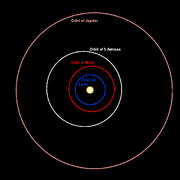5 Astraea
|
A light curve based 3D model of Astraea | |
| Discovery | |
|---|---|
| Discovered by | K. L. Hencke |
| Discovery date | December 8, 1845 |
| Designations | |
| Pronunciation | /æˈstriːə/ a-STREE-ə |
Named after | Astraea |
| 1969 SE | |
| Main belt | |
| Adjectives | Astraean |
| Orbital characteristics | |
| Epoch December 9, 2014 (JD 2457000.5) | |
| Aphelion | 3.065755252 AU (459.202 Gm) |
| Perihelion | 2.08186277 AU (310.688 Gm) |
| 2.573809012 AU (384.945 Gm) | |
| Eccentricity | 0.19113549 |
| 4.129264267 a (1508.213773 d) | |
Average orbital speed | 18.39 km/s |
| 260.189542° | |
| Inclination | 5.368523° |
| 141.59556° | |
| 358.92898° | |
| Proper orbital elements[1] | |
Proper semi-major axis | 2.5761849 AU |
Proper eccentricity | 0.1980486 |
Proper inclination | 4.5118628° |
Proper mean motion | 87.046396 deg / yr |
Proper orbital period |
4.13573 yr (1510.574 d) |
Precession of perihelion | 52.210903 arcsec / yr |
Precession of the ascending node | −57.357951 arcsec / yr |
| Physical characteristics | |
| Dimensions |
167×123×82 km[2] 119 km (mean) |
| 48 300 km2[3] | |
| Volume | 882 000 km3[3] |
| Mass |
2.9×1018 kg[4][5] (assumed)[6] |
Mean density | ~3.3 g/cm³ |
| ~0.023 m/s² | |
| ~0.062 km/s | |
| 0.700 03 d (16.801 h)[2] | |
Equatorial rotation velocity | 6.44 m/s[3] |
| Albedo | 0.227 (geometric)[7] |
| Temperature |
~167 K max: 263 K (-10 °C) |
Spectral type | S-type asteroid |
| 8.74 to 12.89 | |
| 6.85 | |
| 0.15" to 0.041" | |
|
| |
5 Astraea is a large asteroid from the asteroid belt. Its surface is highly reflective (bright) and its composition is probably a mixture of nickel–iron with silicates of magnesium and iron. It is a S-type object in the Tholen classification system.[8]
Astraea was the fifth asteroid discovered, on 8 December 1845, by Karl Ludwig Hencke and named for Astræa, a goddess of justice named after the stars. It was his first of two asteroid discoveries. The second was 6 Hebe. A German amateur astronomer and post office headmaster, Hencke was looking for 4 Vesta when he stumbled on Astraea. The King of Prussia awarded him an annual pension of 1,200 marks for the discovery.[9]
Photometry indicates prograde rotation, that the north pole points in the direction of right ascension 9 h 52 min, declination 73° with a 5° uncertainty.[2] This gives an axial tilt of about 33°.
Astraea is physically unremarkable but notable mainly because for 38 years (after the discovery of Vesta in 1807) it had been thought that there were only four asteroids.[10] With an apparent magnitude of 8.7 (on a favorable opposition on 15 February 2016), it is indeed only the seventeenth-brightest main-belt asteroid, and fainter than, for example, 192 Nausikaa or even 324 Bamberga (at rare near-perihelion oppositions).
After the discovery of Astraea, thousands of other asteroids would follow. Indeed, the discovery of Astraea proved to be the starting point for the eventual demotion of the four original asteroids (which were regarded as planets at the time)[10] to their current status, as it became apparent that these four were only the largest of a whole new type of celestial body.
An occultation on 6 June 2008 produced an effective diameter (silhouette) of 115 ± 6 km.[11]
Astraea has been studied by radar.[12] Arecibo observed Astraea in March 2012.[13][14]


Right: The orbit of 5 Astraea in white compared with those of Earth, Mars and Jupiter.
See also
References
- ↑ "AstDyS-2 Astraea Synthetic Proper Orbital Elements". Department of Mathematics, University of Pisa, Italy. Retrieved 2011-10-01.
- 1 2 3 M. J. López-Gonzáles & E. Rodríguez Lightcurves and poles of seven asteroids, Planetary and Space Science, Vol. 53, p. 1147 (2005).
- 1 2 3 Calculated based on the known parameters
- ↑ Michalak, G. (2001). "Determination of asteroid masses". Astronomy & Astrophysics. 374 (2): 703–711. Bibcode:2001A&A...374..703M. doi:10.1051/0004-6361:20010731. Retrieved 2008-11-10.
- ↑ (Mass estimate of Astra 0.015 / Mass of Ceres 4.75) * Mass of Ceres 9.43E+20 = 2.977E+18
- ↑ Michalak2001 (Table 6) assumed masses of perturbing asteroids used in calculations of perturbations of the test asteroids.
- ↑ Supplemental IRAS Minor Planet Survey
- ↑ "JPL Small-Body Database Browser: 5 Astraea
- ↑ "Dawn Community". NASA. Archived from the original on 21 May 2009. Retrieved 2009-04-17.
- 1 2 "The Planet Hygea". spaceweather.com. 1849. Archived from the original on 9 April 2008. Retrieved 2008-04-18.
- ↑ Ďurech, Josef; Kaasalainen, Mikko; Herald, David; Dunham, David; Timerson, Brad; Hanuš, Josef; et al. (2011). "Combining asteroid models derived by lightcurve inversion with asteroidal occultation silhouettes" (PDF). Icarus. 214 (2): 652–670. arXiv:1104.4227
 . Bibcode:2011Icar..214..652D. doi:10.1016/j.icarus.2011.03.016.
. Bibcode:2011Icar..214..652D. doi:10.1016/j.icarus.2011.03.016. - ↑ "Radar-Detected Asteroids and Comets". NASA/JPL Asteroid Radar Research. Retrieved 2012-01-23.
- ↑ Mike Nolan (2012-01-18). "Scheduled Arecibo Radar Asteroid Observations". Planetary Radar at Arecibo Observatory. Retrieved 2012-01-23.
- ↑ http://www.naic.edu/~pradar/
External links
- JPL Ephemeris
- 2 Telescope images of 5 Astraea
- AN 23 (1846) 393 (in German)
- MNRAS 7 (1846) 27
- 5 Astraea at the JPL Small-Body Database

.png)